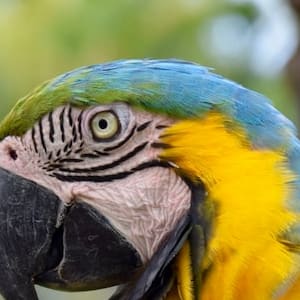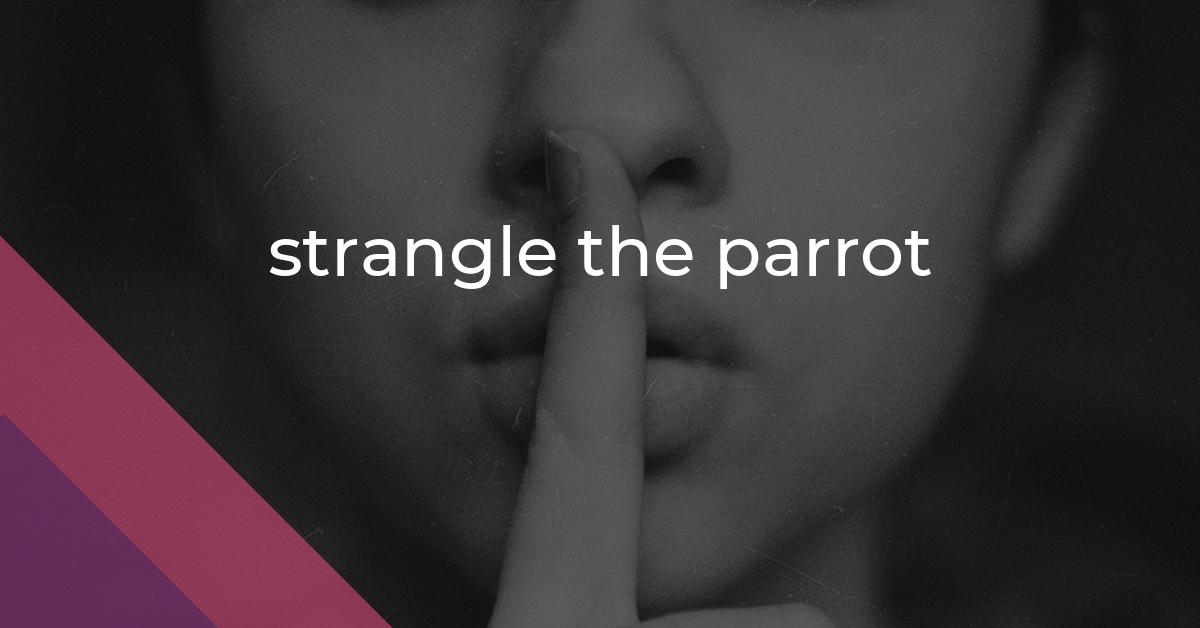strangle the parrot: Idiom Meaning and Origin
What does ‘strangle the parrot’ mean?
The idiom "strangle the parrot" means to silence or suppress someone or something, usually in a forceful or oppressive manner.

Idiom Explorer
The idiom "tell someone where to shove it" means to angrily reject or dismiss someone or something, often with hostility or contempt.
The idiom "teach someone a lesson" means to make someone experience an unpleasant consequence in order to discipline or show them the negative consequences of their actions.
The idiom "talk someone out of something" means to persuade or convince someone not to do or pursue something that they were planning or considering.
The idiom "take someone's head off" means to yell or speak to someone angrily or aggressively.
The idiom "stuff it" means to forcefully or angrily tell someone to be quiet or stop talking. It is a direct and rude way of asking someone to stop speaking or expressing their opinion.
The idiom "stop someone in their tracks" means to halt or interrupt someone suddenly, causing them to pause or cease their current action or thought. This expression implies a strong, unexpected impact or surprise that prevents further progress or movement.
The idiom "spit feathers" means to be extremely angry or frustrated.
The idiom "spank the monkey" is a colloquial expression that refers to the act of masturbating. It is considered vulgar and should be used cautiously in polite conversation.
The idiom "snap someone's head off" means to respond to someone in a rude, aggressive, or overly hostile manner. It implies a sharp and dismissive reaction, often leaving the other person feeling disrespected or intimidated.
FAIL
The idiom "strangle the parrot" is an intriguing phrase that has its origin in the world of theater and entertainment. This particular idiom finds its roots in the early 20th century and has a distinct connotation related to censorship and suppression of freedom of speech.
The phrase "strangle the parrot" is believed to have emerged in the vaudeville era, a popular form of entertainment that encompassed a variety of acts including comedy sketches and musical performances. During this era, performers often utilized a wide range of props to enhance their acts, and one such prop was a live parrot.
In the vaudeville shows, the parrot was known to mimic the speech and actions of the performers, providing an element of novelty and amusement to the audience. However, as with any live performance, there was always the risk of something going awry. It was not uncommon for the parrot to imitate inappropriate or controversial content, inadvertently causing discomfort or offense to the spectators.
To counteract such incidents, show producers and theater owners introduced a practice known as "strangling the parrot." This involved a designated individual, often an assistant or staff member, who was responsible for discreetly strangling the parrot by covering its mouth or preventing it from making any sound. This action effectively silenced the parrot, ensuring that any potentially offensive remarks or actions would not reach the ears or eyes of the audience.
Over time, the phrase "strangle the parrot" began to be used as a metaphorical expression to describe acts of censorship or suppression, particularly in the context of limiting free speech or preventing the expression of controversial ideas. It became associated with muzzling dissenting voices or stifling creativity in various spheres of life.
In the realm of idiomatic language, "strangle the parrot" is related to several other idioms that convey similar ideas of censorship and control of expression. One such idiom is "choke off," which means to suppress or cut off the flow of something, often used in the context of cutting off discussion or preventing the dissemination of information. Another related idiom is "force something down someone's throat," which implies imposing an idea or belief on someone forcefully and without their consent.
Similarly, the idiom "shove something down someone's throat" also conveys the notion of imposing something forcefully onto another person, often used to describe the act of compelling someone to accept or believe something against their will. Additionally, the idiom "clip someone's wings" is related to the idea of restricting or curtailing someone's freedom or ability to act or express themselves.
The final idiom related to "strangle the parrot" is "put a gun to someone's head," which metaphorically represents forcing someone to do something against their will, often through intimidation or threat of harm. This idiom implies a high level of coercion and control, emphasizing the idea of suppressing an individual's freedom to choose or express themselves.
Though predominantly known in the realm of idiomatic language, "strangle the parrot" has occasionally been used in political and social contexts as well. In these instances, it serves as a critical commentary on attempts to silence opposing viewpoints or stifle open discussion.
This idiom not only captures the historical anecdotes of the vaudeville era but also resonates with our ongoing societal debates on freedom of expression and the boundaries imposed on speech. It sheds light on the delicate balance between maintaining order and allowing for diverse perspectives.
In exploring the meaning and origin of "strangle the parrot," we delve into the rich tapestry of idiomatic language and its ability to encapsulate complex ideas within succinct phrases. While the specific origins of this phrase may be traceable to a particular context, the interpretation and usage of idioms are fluid and continue to evolve over time.
The idiom "strangle the parrot" reminds us of the power of language and its potential to be suppressed or silenced. It invites us to question the limits we impose on expression and the consequences of stifling dissent. As we contemplate the significance of this idiom, we are prompted to consider the broader implications and sometimes unforeseen effects of censorship in our society.
Example usage
Examples of how the idiom "strangle the parrot" can be used in a sentence:
- He strangled the parrot when he accidentally blurted out the surprise party plans.
- The politician skillfully strangled the parrot by evading direct answers during the press conference.
- She decided to strangle the parrot and keep her true feelings to herself to avoid any conflicts at work.
More "Communication" idioms



